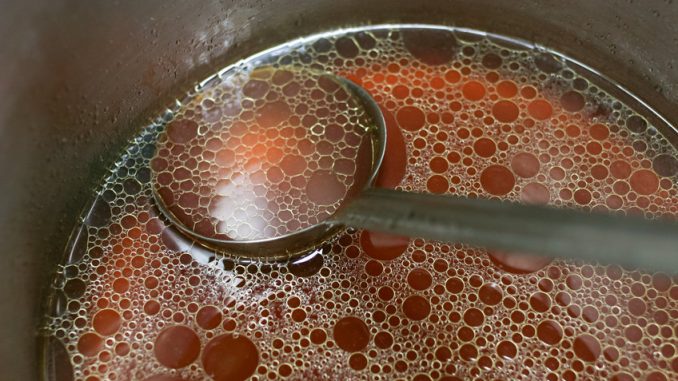
The classic brown stock is the base for a host of sauces and there are many variations. It requires a certain amount of time in its preparation and is possibly one of the most time-consuming of all kitchen activities. However, its preparation is a mark of considerable interest and skill because it is at the heart of cuisine. The great chef Escoffier brought together many of the different recipes that had been available on its preparation and made it a uniform activity.
The brown stock is generally prepared from the shin bones of veal beef that need to be cracked so that the marrow can be seen. A certain amount of meat needs to be available too which will infuse into the stock as its is cooked. Veal has always been preferred but other beef cuts are often used such as knuckles and ribs. When other cuts are used then the brown stock is no longer a brown veal stock but the basic stock described here.
The use of salt is often at the discretion of the chef with stock but Escoffier leaves this out because it is often added when sauces are made up and other ingredients added in the final preparation of a sauce or soup.
If a very clear stock is to be produced then the marrow needs to be removed from the cracked bones otherwise leave it if a cloudy stock is required as for gravy.
The process usually takes all day – about 8 hours in all is needed to get a decent release of meat material. Any longer and the stock loses its flavour. Some chefs would only consider a low simmer of 3 or 4 hours simply because they don’t want to ruin all the flavour.
Ingredients:
- 4 litres/quarts of cold water
- 1 teaspoon of salt although this can by rights be left out
Preparation:
- Heat the oven to 200ºC/400ºF
- If the bones are uncooked it would improve the flavour if they are partially roasted. All the available bones are laid out on a metal tray and roasted for an hour at least until browned. Some chefs do not bother with this step but there is a distinct difference in flavour.
- Take all the bones with the meat and place in the water for the stock. Leave to steep for about 30 minutes to an hour for all the material to infuse.
- Bring gently to a point almost of boiling but just drop down and allow to simmer for an hour.
- Remove the white scum with a ladle
- Add the vegetables and maintain the simmer for another four to five hours.
- The larger bones are removed and generally discarded although some chefs like to do a second boil in about 1 quart of water. The amount of flavour obtained is very minimal according to our local chefs so this steps seems pointless.
- Strain through a metal sieve into a large bowl to remove the smaller bones and vegetable remains.
- Allow to cool but remove the congealed floating fat as carefully as possible to avoid forming a cloudy emulsion.
This stock will store in a sealed container for a couple of weeks if refrigerated.
The stock can also be reduced further by a rapid boil and concentrated to a half or quarter of its volume. This process will change its flavour and there is some reluctance to overdo this because the higher meat aromas will disappear.
Leave a Reply